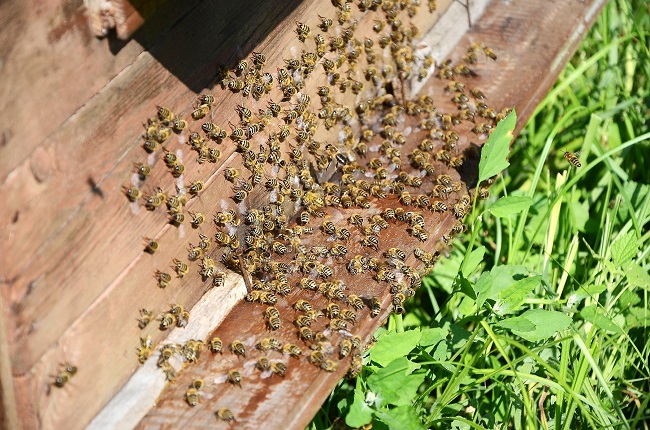
Beekeeping has been gaining popularity as a rewarding and environmentally conscious hobby. Not only does it provide an opportunity to harvest your own honey, but it also supports pollinator populations and contributes to the health of local ecosystems. Starting a backyard beehive is an exciting venture, but it requires careful planning and consideration, especially when it comes to the safety of children and pets. In this article, we will guide you through the steps of setting up a backyard beehive while prioritizing the well-being of your family members, both human and furry.
Research and Education
Before embarking on your beekeeping journey, it’s crucial to arm yourself with knowledge. Attend local beekeeping classes, workshops, or webinars to gain a thorough understanding of bee behavior, hive management, and safety protocols. Engage with experienced beekeepers to learn from their expertise and gain practical insights.
Selecting the Right Hive Location
Choosing the appropriate location for your beehive is paramount. Choose an area that receives adequate sunlight while being sheltered from strong winds. Ensure the hive is elevated on a sturdy stand to prevent flooding and discourage curious pets or children from getting too close.
Setting Up the Hive
Invest in high-quality beekeeping equipment, including protective clothing such as veils and gloves. When assembling the hive, follow the manufacturer’s instructions meticulously. Be sure to leave ample space around the hive for easy access and maintenance.
Beekeeping Safety Measures
Here are some safety precautions to follow when working with your backyard beehive:
Protective Gear
Whenever you’re tending to your beehive, wear full beekeeping attire, including a veil, suit, and gloves. This protective gear not only shields you from bee stings but also reassures children and pets that you are safe.
Quiet Movements
Bees are sensitive to sudden movements and vibrations. Teach children to remain calm and move slowly around the hive to avoid disturbing the bees.
Smoke Usage
The judicious use of a bee smoker can help calm bees during hive inspections. Ensure that children and pets are at a safe distance when you’re using the smoker.
Time of Day
Schedule hive inspections during the late afternoon or early evening when bees are less active. This reduces the chances of accidental stings.
Educating Children
Teaching your children about bees and their importance is an excellent way to involve them in your beekeeping endeavor safely.
Explain the Role of Bees
Help children understand the critical role bees play in pollinating plants and producing honey, fostering a sense of appreciation and respect.
Observational Learning
Allow children to observe hive inspections from a safe distance. Explain the process, the tools used, and the reasons behind each action.
Hands-On Involvement
As children grow older, involve them in hive inspections under close supervision. Teach them how to handle bees gently and the importance of staying calm.
Pets and Beehives
Introducing your pets to the beehive requires careful planning.
Training
Train dogs and cats to respect the beehive area. Use commands to discourage them from approaching the hive.
Barriers
Erect a low fence or barrier around the hive to prevent pets from getting too close. This physical boundary provides an added layer of safety.
Supervision
Always supervise pets when they are in the vicinity of the beehive. Over time, they may become accustomed to the bees and lose interest.
Conclusion
Starting a backyard beehive is a fulfilling endeavor that offers numerous benefits, but safety should always be a top priority. By taking the time to educate yourself, implementing proper safety measures, and involving children and pets in a controlled and educational manner, you can create a harmonious environment where both humans and bees can thrive. As you embark on this journey, remember that responsible beekeeping practices and safety precautions are key to a successful and enjoyable experience for everyone involved.
15 Fun Facts About Beehives
Hexagonal Wonder
Bees are master architects. They construct their honeycomb cells in a hexagonal shape, which is the most efficient way to maximize storage space while using the least amount of wax.
Royal Treatment
In a beehive, the queen bee reigns supreme. She is the only fertile female and can lay up to 2,000 eggs per day, ensuring the colony’s survival and growth.
Air Conditioning
Bees are natural climate control experts. They fan their wings to regulate the temperature inside the hive, maintaining it around 93-95°F even in varying external conditions.
Dances of Communication
Bees have an intricate dance language. The “waggle dance” is performed by worker bees to communicate the location of food sources to their hive mates. The direction and duration of the dance convey distance and direction.
Collective Decision-Making
When it’s time for the colony to find a new home, scout bees explore potential sites. They return to the hive and perform a “decision-making dance” to communicate the merits of the different options, ultimately leading to a group consensus.
Nectar to Honey
Bees transform nectar into honey through a process of regurgitation and evaporation. They add enzymes to the nectar, break down its complex sugars, and then fan it with their wings to reduce water content, resulting in the thick, sweet substance we know as honey.
Busy Workers
Worker bees are tireless. During peak foraging season, they may visit up to 1,500 flowers in a single day to collect nectar and pollen.
Wax Production
Bees produce beeswax from special glands on their abdomens. To create 1 pound of beeswax, bees must consume about 6-8 pounds of honey.
Bee Bread
Pollen collected by bees is mixed with nectar and enzymes, creating “bee bread.” This nutritious substance serves as protein-rich food for developing bee larvae.
Honey’s Long Shelf Life
Archaeologists have discovered pots of honey in ancient Egyptian tombs that are over 3,000 years old and still perfectly edible. Honey’s low water content and acidic pH contribute to its long shelf life.
Beehive Chemistry
The unique aroma and flavor of different types of honey are influenced by the flowers from which bees collect nectar. This diversity is due to the specific enzymes and compounds present in each flower’s nectar.
Swarm Survival
Swarming is a natural process of colony reproduction. When a hive becomes overcrowded, a new queen is raised, and the old queen, along with a large portion of the worker bees, leaves to form a new colony. This ensures the survival of the species.
Beehive’s Defense Mechanism
Bees use propolis, a resinous substance collected from trees to seal and reinforce their hive. It helps protect the colony from pathogens, insects, and other invaders.
Hive Hygiene
Bees are meticulous about keeping their hive clean. Dead bees, debris, and even large intruders are removed from the hive and deposited some distance away to prevent disease transmission.
Honeybee Lifespan
The lifespan of a worker bee is relatively short, typically around 6 weeks during the summer foraging season. However, a queen bee can live for several years.
Related Articles & Free Email Newsletter Sign Up
How to Attract Bees, Butterflies, and Birds to Your Garden
How to Make a Bee Friendly Garden




Comment here